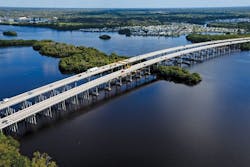NO. 3 BRIDGE: Top-down approach
The I-75 Caloosahatchee River Bridge Widening project was the last piece of a 10-year puzzle for the Florida Department of Transportation (FDOT). Completed and open to traffic in the first week of November 2015, the bridge was one of eight bridges improved along I-75 in Collier County, Fla.
The $72 million bridge-widening project spanning over the Caloosahatchee River is part of a larger road project, which set out to reconstruct and widen I-75 from the existing four-lane structure to eight lanes, and adding an auxiliary lane in each direction.
“The Caloosahatchee River Bridge was the main bridge, as opposed to other ones which were pretty low-level bridges, which weren’t as complicated as the other bridges,” FDOT’s Nik Patel told Roads & Bridges.
The bridge is a simple-span bridge on driven pile foundations and columns with Type II, III and IV AASHTO girders on the approach of the spans and curve structural steel plate girders at the main channel spans.
What made the project more complicated than the previous reconstruction of seven bridges along I-75 was the environmental sensitivity of the project.
The Caloosahatchee River is home to the second-largest population of manatees in the state of Florida. FDOT’s reconstruction plans required extra attention and coordination with eight different permitting agencies that had to be involved in the design, permitting and construction phases of the project.
FDOT, along with numerous government agencies including the Florida Fish and Wildlife Commission, U.S. Army Corps of Engineers, U.S Coast Guard, South Florida Water Management District and the Florida Department of Environmental Protection, identified 25 protected animals and 17 protected plant species potentially located within the bridge project.
In addition, the Caloosahatchee Wildlife Refuge is located directly beneath the I-75 Caloosahatchee River Bridge, making wildlife preservation a top priority. Permitting conditions required a manatee spotter to be present while work was taking place. If a manatee was spotted, construction work halted until the endangered species left the area.
Driven by environmental concerns surrounding the project, FDOT crews utilized “top-down” construction to complete the bridge expansion. The process involved building prefabricated sections of the bridge near the Caloosahatchee river banks using cranes on temporary beams controlled by GPS.
Constructing the bridge using temporary trestle construction and the use of two straddle cranes minimized traffic disruption and environmental impact to the endangered wetland species. R&B
PROJECT: I-75 Caloosahatchee River Bridge Widening
LOCATION: Ft. Myers, Fla.
OWNER: Florida Department of Transportation
DESIGNER: Stantec
CONTRACTOR: de Moya/Leware joint venture
COST: $72 million
LENGTH: 3,904 ft
COMPLETION DATE: Nov. 5, 2015
